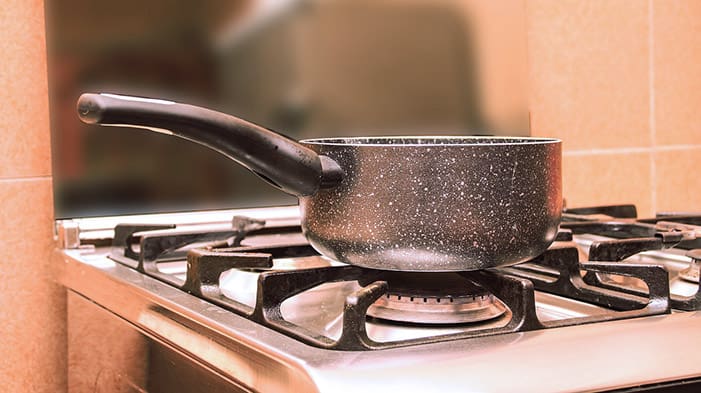We’ve all been there: one moment you’re holding it in your hands, the next you’re trying to catch it before it falls into the toilet.
Sounds familiar?
In fact, things fall into the toilet pretty often, especially, if the toilet is in the bathroom and not in a separate room. I’ve seen many things in toilets, including phones, (sun)glasses, toothbrushes, dentures, keys, wallets, and retainers.
If you’re lucky, you can fish the item out of the toilet bowl; if you can’t, whatever you dropped in it, chances are good that you won’t see it again (except if it clogs the drain the plumber finds it).
Fortunately, many things can be saved by applying a simple disinfecting (or sterilizing) process. This way you can easily get rid of harmful viruses and bacteria and continue to use the item safely.
So, don’t panic if you have just dropped something into the toilet. If you disinfect it using one of the methods from the list, you’ll be good to go.
Let’s see the details:
Things You Can Disinfect Successfully After Dropping Into The Toilet
Unfortunately, you can’t make everything completely germ-free after falling into the toilet. As an example, here are some common materials that can be disinfected pretty easily and effectively:
- plastic
- metal
- textile
- glass
- wood
- ceramic
Of course, the above list is not exhaustive, so if you dropped something in the toilet that’s made of a different material, you might still be able to disinfect it using one of the methods listed below.
FYI – Leather (even faux leather) is a pretty delicate material. Therefore, if you dropped a leather accessory, such as a purse or wallet in the toilet, make sure you check out this article that is exclusively about disinfecting stuff made of leather.
Before we move on to the different techniques, it’s important to note that if something falls in the toilet, you should act quickly (especially if the item is small) and take it out from the toilet before it disappears in the pipe.
Urine and stool contain a bunch of pathogens, so it’s recommended to use protective gloves when you touch the inside of the toilet. However, if you don’t have time to put them on, wash your hands thoroughly with soap or use a hand sanitizer afterward.
Note: Make sure you always read the label before using any of the following chemicals because many of them can be hazardous to your health when used improperly. Also, wear protective gloves and goggles to prevent injuries.
1. Rubbing Alcohol: Great Choice for Home Use and Non-Personal Care Items
Alcohol (ethyl alcohol or isopropyl alcohol) is a well-known and commonly used disinfectant. When used in a proper concentration, that is to say, between 60% and 90%, it kills most germs, including viruses, bacteria, and fungi.
The major drawback of using alcohol as a disinfectant is that it won’t kill bacterial spores (1). For instance, Clostridium difficile is a relatively common bacteria that can be found in many people’s colon. Usually, it does not cause any problem, however, sometimes (often after taking antibiotics) it begins to multiply and produce spores that can persist in the toilet (2).
This is often a greater concern regarding toilets in hospitals, malls, and other community spaces because there’s a higher chance that an infected person used the toilet before. It’s usually much less of an issue at home.
Another thing you should know is that, unlike ethyl alcohol, isopropyl alcohol is ineffective against non-lipid enteroviruses.
So is alcohol effective against germs?
The answer is a definite yes. If something has fallen in the toilet, you can use alcohol at a concentration of 60%-80% to disinfect it. Just make sure that alcohol remains on the surface of the object for a few minutes.
At lower concentrations alcohol has only sanitizing effects, that is to say, it will lower the number of germs but to a lesser extent than disinfecting.
For instance, disinfecting wipes that contain at least 60% alcohol offer a convenient solution to clean your phone.
These wipes usually won’t do any harm to your phone, however, if you have any doubts, read the user manual or ask the manufacturer.
Alcohol is also great for disinfecting your keys and other things made of metal.
In the case of public toilets and personal care products, such as toothbrushes, however, I would recommend using something more potent than alcohol in order to kill all kinds of pathogens.
2. Hydrogen Peroxide: For Both Disinfection and Sterilization
Hydrogen peroxide is another highly effective disinfectant. It kills most bacteria, viruses, and fungi within minutes. It’s also effective against most spores but only after 6 hours and at a concentration of 7.5% (3).
Hydrogen peroxide works great with glass and most types of plastic, so, for instance, it’s perfect to disinfect your plastic toothbrush. However, your safest bet is, without a doubt, to replace your contaminated toothbrush with a new one.
Do NOT use hydrogen peroxide for metal items because it’s a strong oxidizer, thus it can easily damage metals. Keep in mind that electrical toothbrushes usually contain metal.
Solutions that contain at least 7.5% hydrogen peroxide can be used for both sterilization and disinfection.
If you want to sterilize (make it completely free of germs) something that fell in the toilet, you have to expose it to a 7.5% hydrogen peroxide solution for at least 6 hours at room temperature. For disinfection, 30 minutes is enough.
Note: Hydrogen peroxide can cause severe eye damage and skin burns, so make sure you wear protective gloves and goggles while using it.
3. Heat Kills Germs: Boiling & Ironing

Heat is highly effective against pathogens, including viruses, bacteria, and protozoa. According to the WHO, bacteria are more sensitive to heat than viruses. Also, viruses are usually inactivated more slowly than most bacteria.
Different species are sensitive to heat to varying degrees.
That is to say, some of them will be killed at 140°F (60°C) in just a few seconds, while others survive at temperatures higher than 175°F (80°C).
As a rule of thumb, the higher the temperature and the longer the object is exposed to heat, the more pathogens will be inactivated and killed.
Therefore, placing something into boiling water for a few minutes is a powerful way of disinfection. Ironing is also a great way to make cloth germ-free.
The drawback of this method is that not everything can be exposed to high temperatures without damaging the material.
For instance, things made of metal, glass, and ceramic can be disinfected using boiling water. On the other hand, many types of plastic will deform or even melt when exposed to high temperatures.
Menstrual cups, for instance, often fall in the toilet. Some models can be exposed to high temperatures while others will be damaged in boiling water (you should ask the manufacturer about the one you own). Often it’s a better idea to replace the contaminated cup with a new one instead of disinfecting it.
Using your dryer can also help you get rid of germs, here you can check out the details.
4. Bleach: Microbes Hate Chlorine
Bleach is a widely used chlorine disinfectant that contains hypochlorite as an active agent. Household bleach usually contains about 5-8% sodium hypochlorite. This amount is more than enough to provide an effective antimicrobial activity.
In fact, if you make a 1:10 dilution of bleach, that solution will kill most viruses, bacteria, protozoa, and fungi within just a few minutes (4). Of course, the more concentrated bleach you use, the less time it will take to eliminate germs.
Bleach works best with things made of plastic, glass, and ceramic. You can also use it to disinfect the toilet itself.
Keep in mind that bleach can cause serious injuries when used improperly, so make sure you read the label and use the suggested protective equipment.
5. Soap and Warm Water
While it’s true that soap is neither a disinfectant nor a sanitizer, it can inactivate certain types of viruses by disintegrating their lipid membrane. However, the main benefit of using soap is that it helps to remove germs mechanically from a surface.
Of course, this method is not as effective as the previous ones, therefore it’s not recommended for cleaning personal care products. That being said, it can be really handy when harsh chemicals can’t be used.
For instance, if you drop your glasses in the toilet, it’s not recommended to use any of the above-mentioned chemicals to clean the lenses. However, soapy water can often be applied without causing any damage.
Soap is cheap, widely accessible, and can be found in literally every household. It does not kill all pathogens but it does help to remove them from most surfaces. So don’t underestimate the power of soapy water. Sometimes it’s the only viable way to clean a dirty item.











